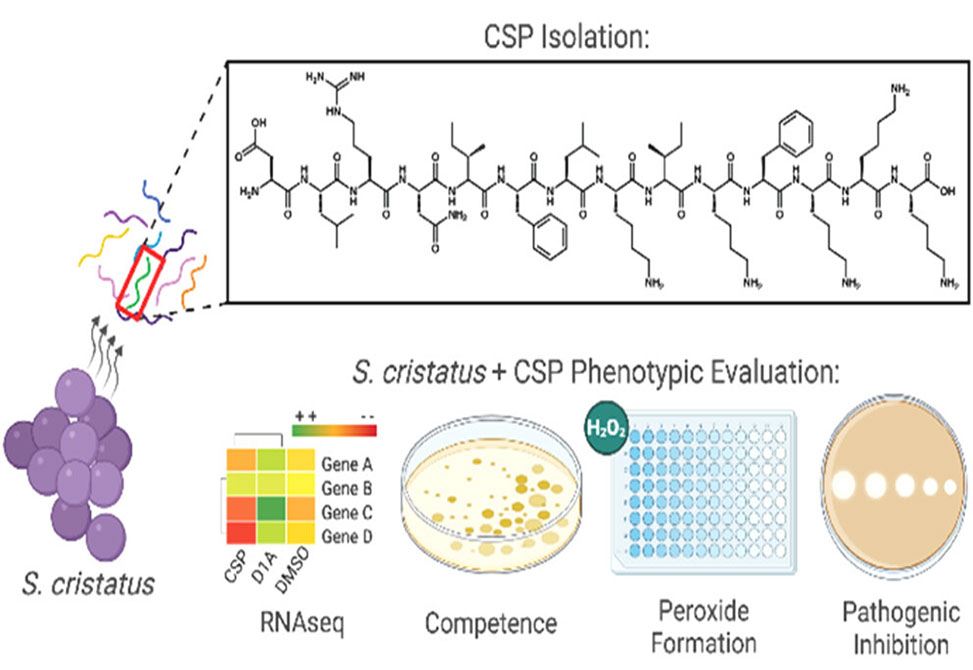Quorum Sensing
Reflecting work in the Tal-Gan Lab
Streptococcus cristatus, a commensal member of the oral microbiota and recently reclassified from Streptococcus oligofermentans, has emerged as a promising candidate in the pursuit of biotherapeutics targeting oral pathogens. A comprehensive study from the Tal-Gan Research Group at the University of Nevada at Reno, published in ACS Chemical Biology, explores the quorum sensing, QS, mechanisms in S. cristatus, specifically the competence-stimulating peptide, CSP, and its downstream regulon, shedding light on how this innocuous organism could be leveraged to suppress Streptococcus mutans, the primary culprit behind dental caries.
Unlike traditional antibiotic approaches, S. cristatus exerts antimicrobial activity through endogenous mechanisms, particularly via hydrogen peroxide, H2O2, production. Previous work has shown that commensal streptococci like S. gordonii and S. sanguinis use QS-regulated pathways to produce inhibitory compounds, curbing the virulence of species like S. mutans. Given its low pathogenic potential and ability to generate H2O2 in proximity to S. mutans, S. cristatus has garnered interest for its natural antagonistic properties.
At the heart of the study is the identification and functional validation of the native CSP used by S. cristatus. Genomic analysis and Sanger sequencing confirmed a 14-mer peptide, DLRNIFLKIKFKKK, which shares strong similarity with peptides from other Mitis group streptococci. The peptide was successfully isolated from culture supernatants using RP-HPLC and confirmed through MS/MS, aligning with previous detection in human saliva samples.
To quantify CSP activity, the authors developed a luciferase-based QS reporter strain responsive to the comX promoter. This system not only allowed detection of endogenous CSP production during early logarithmic growth but also measured activation profiles in response to synthetic analogs.
A suite of synthetic CSP analogs —including alanine scans, D-amino acid substitutions, and truncations— was synthesized via solid-phase peptide synthesis to parse out the functional contribution of each residue. Results from SAR analysis revealed that the N-terminal region, particularly Asp1 and Arg3, is critical for ComD receptor binding and activation, while the C-terminal lysine-rich tail was largely dispensable for bioactivity.
Interestingly, certain analogs exhibited inhibitory effects, such as CSP-D1A and CSP-desD1L2, which acted as competitive antagonists in the presence of native CSP. Circular dichroism spectroscopy confirmed that many active analogs adopted α-helical conformations in membrane-mimicking environments, TFE, though no strict correlation between helicity and activity was found.
RNA-seq analysis 10 minutes after CSP exposure showed a robust upregulation of canonical competence genes, including the comG operon, dprA, and comE. These genes are involved in DNA uptake and transformation, underscoring the activation of the competence regulon. Conversely, genes related to sugar metabolism and PTS transport systems were downregulated, reflecting a metabolic shift toward QS-related activity. However, genes specifically linked to H2O2 or bacteriocin production were not significantly upregulated at this time point, suggesting that timing and external stimuli may modulate their expression.
Phenotypic assays validated the transcriptomic findings. Exposure to native CSP enabled S. cristatus to uptake exogenous plasmid DNA containing spectinomycin resistance, demonstrating functional competence. The inhibitory analogs successfully blocked transformation when co-administered, supporting their utility in CSP pathway modulation.
Despite no observed effect on biofilm formation, hydrogen peroxide assays revealed that CSP exposure significantly increased H2O2 production, particularly at higher concentrations. This production was attenuated by CSP antagonists, affirming partial QS control over this phenotype.
The ultimate test of S. cristatus's biotherapeutic potential came in the form of agar plate assays, where it was co-cultured with S. mutans. Clear zones of inhibition appeared around S. cristatus colonies exposed to high CSP concentrations, especially when plated against an S. mutans strain lacking mutacin production, ΔcomC. These results confirm that S. cristatus, when primed via QS, can antagonize S. mutans through mechanisms likely involving peroxide formation.
This study establishes a sophisticated QS network in S. cristatus centered on a well-defined CSP and a highly conserved comABCDE regulon. The systematic dissection of CSP structure, coupled with transcriptomic and phenotypic validation, offers critical insights into the regulatory logic underlying competence and interspecies interaction. Most importantly, it elevates S. cristatus as a viable candidate for probiotic or peptide-based strategies to mitigate the colonization and virulence of S. mutans, marking a step toward non-antibiotic dental therapies grounded in microbial ecology.


